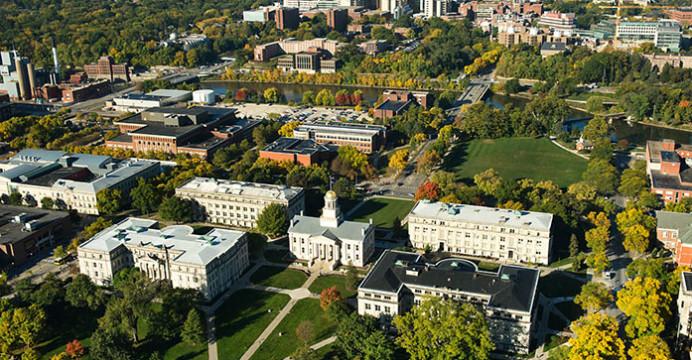A group of scholars is working to spread science to the masses.
University of Iowa students in the Latham Fellowship Program demonstrated their projects last week, an initiative that is encouraging community outreach and engagement with young scientists. Students were able to freely choose the topics of their projects, which did not go unnoticed.
The Fellowship Program was established through the generous donation of Robert J. and Sue B. Latham to help enhance research opportunities for selected undergraduate students.
Erin Maier, a UI junior majoring in astronomy and physics, showcased a telescope viewing east of the Old Capitol on the Pentacrest; 108 people stopped by, she said, which resulted from advertising the event on Facebook the night before.
“As people were walking by, we’d kind of call out, ‘Hey, want to look at Jupiter?’ ” Maier said.
“They kind of look at us like, ‘Are you talking to me? Yes, I want to look at Jupiter.’ ”
Maier said she appreciated piquing people’s interest who might have not otherwise been inclined to learn about astronomy. She displayed the red giant Beetlejuice, the red giant in the Orion constellation.
“We could see it go supernova between now and a million years from now,” Maier said. “It’s at its stage in life where once it goes supernova, we won’t know for 600 years because it’s that far away.”
The program itself focused on communication in the first semester and allowed time for the projects in the second semester, said Lori Adams, a deputy director for Latham.
She said communication is key for young scientists to understand, not only in working with other scientists but to explain the work to the broader community.
“There’s educational value in that they’re learning skills in science communications,” Adams said. “Through that, students understand their own research better. When you’re communicating, it helps you understand the bigger picture.”
Other projects included a comic book used to break down complex ideas, a student writing a Spanish blog to bridge communication barriers, using improvisational comedy, and podcasts to share ideas in the community, among others. Three group projects were displayed as well.
Cornelia Lang, an associate professor in the Physics & Astronomy Department, said the program is a positive initiative because communication is essential for scientists to understand.
Aside from working with colleagues and presenting research, Lang said, the program allows for community outreach. It also helps when explaining projects that require funding in legislation, where simplifying topics is crucial.
Adams added that it was rewarding to see students explore the science projects while also proving their creative sides in the process.
“The students are as talented in art and writing as they are passionate about science,” she said. “It was way beyond what I would’ve imagined. It really demonstrates what students can do.”
Ordinarily, students interested in viewing stars would go to the roof of Van Allen Hall, where there is public viewing of a large telescope every weeknight.
However, Maier said, many students may not even know they have interest. When people put the learning opportunity in a central walking location, she said, other people happily engage with what’s going on.
“It’s great because you see that people really are interested on a fundamental level,” Maier said. “People just find themselves shut out sometimes by the perceived complexity of science. People are very interested, and if you engage with them, they will engage with you back.”
Maier said the scientific community is placing more emphasis on community engagement and the broader impact of research, but it can be a slow process. She said she’s proud to be in a group helping to pave the way.
“Increasingly, scientists and researchers need to describe to others what they’re doing. Starting early is very important,” Lang said. “If you just stay in your lab, you don’t necessarily expose yourself to the opportunities out there.”



